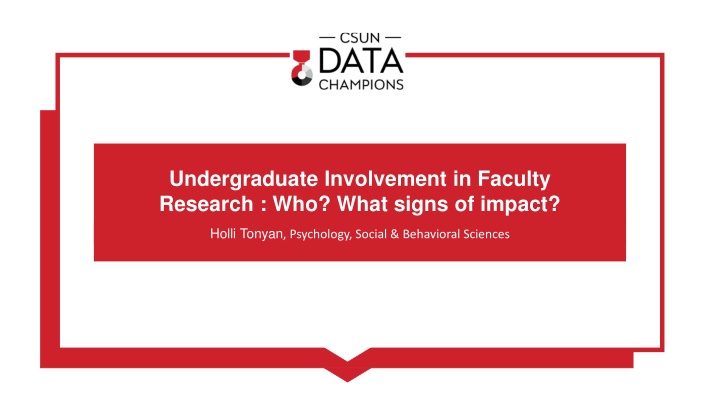
Impact of Undergraduate Involvement in Faculty Research on Student Success at CSUN
Explore the impact of undergraduate involvement in faculty research on student success at CSUN, focusing on tracking methods, student characteristics, and academic achievement. Discover findings, comparisons, and concluding thoughts for potential future research endeavors.
Download Presentation

Please find below an Image/Link to download the presentation.
The content on the website is provided AS IS for your information and personal use only. It may not be sold, licensed, or shared on other websites without obtaining consent from the author. If you encounter any issues during the download, it is possible that the publisher has removed the file from their server.
You are allowed to download the files provided on this website for personal or commercial use, subject to the condition that they are used lawfully. All files are the property of their respective owners.
The content on the website is provided AS IS for your information and personal use only. It may not be sold, licensed, or shared on other websites without obtaining consent from the author.
E N D
Presentation Transcript
Undergraduate Involvement in Faculty Research : Who? What signs of impact? Holli Tonyan, Psychology, Social & Behavioral Sciences
Are there small simple steps CSUN could take to track the impact of undergraduate involvement in faculty research on student success? UIR: Undergraduate involvement in research Pilot a way to track UIR via annual reporting Compare PSY UIR: averages for students who were involved in scholarship with PSY faculty PSY major: averages for all PSY majors What other considerations led you to your project topic? Psychology faculty already regularly report the names of students who are volunteering in their labs as part of annual reporting and have done so since 2014-15 Guiding Questions
Annual lists of student names obtained from the Psychology Department Chair. Compiled and organized into one list of all PSY UIR. Emailed individual faculty to obtain students CSUN ID and/or email address to facilitate matching Psychology data with IR data. Created one list to share with IR. The compiled list was sent to IR. IR provided data about student characteristics and academic achievement. Overview of Data
Similar proportion of FTF and Transfer students (PSY UIR: 46%; all PSY major: 46%) PSY UIR were slightly more likely to be White (PSY UIR: 28%; all PSY 22%) and slightly less likely to be Latinx/women/first generation or to receive Pell grants Better academic achievement among PSY UIR, but no discernable change in GPA trajectory Caution: correlation, not causation Findings
Tracking UIR could be useful when simple changes are possible. Faculty could systematically collect CSUN ID (e.g., with CITI training). For future research, code sections of courses that do/do not include UIR Section numbers for courses that involve undergraduate students in research It may be useful to compare sections that do and do not involve undergraduate students in research, if possible Concluding Thoughts






















